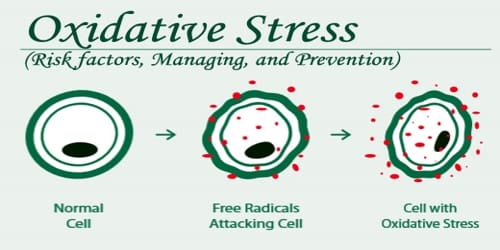Oxidative Stress (Risk factors, Managing, and Prevention)
Definition: Oxidative stress reflects an imbalance between the systemic manifestation of reactive oxygen species and a biological system’s ability to readily detoxify the reactive intermediates or to repair the resulting damage. Free radicals are oxygen-containing molecules with an uneven number of electrons. The uneven number allows them to easily react with other molecules. Free radicals can cause large chain chemical reactions in our body because they react so easily with other molecules. These reactions are called oxidation. They can be beneficial or harmful.
It occurs when excess oxygen radicals are produced in cells, which could overwhelm the normal antioxidant capacity. When the concentration of reactive species is not controlled by internal defense mechanisms such as antioxidants (tocopherols, ascorbic acid, and glutathione) or enzymes involved in oxygen radical scavenging (catalase, peroxidase, and superoxide dismutase, SOD), oxidative damage occurs to proteins, lipids, and DNA, which could lead to cytotoxicity, genotoxicity, and even carcinogenesis when damaged (mutated) cells can proliferate.
Oxidative stress from oxidative metabolism causes base damage, as well as strand breaks in DNA. Base damage is mostly indirect and caused by reactive oxygen species (ROS) generated, e.g. O2− (superoxide radical), OH (hydroxyl radical) and H2O2 (hydrogen peroxide). Further, some reactive oxidative species act as cellular messengers in redox signaling. Thus, oxidative stress can cause disruptions in normal mechanisms of cellular signaling.
Every cell that utilizes enzymes and oxygen to perform functions is exposed to oxygen free radical reactions that have the potential to cause serious damage to the cell. Antioxidants are molecules present in cells that prevent these reactions by donating an electron to the free radicals without becoming destabilized themselves. An imbalance between oxidants and antioxidants is the underlying basis of oxidative stress.

Risk factors of Oxidative stress: Oxidative stress leads to many pathophysiological conditions in the body. Some of these include neurodegenerative diseases such as Parkinson’s disease and Alzheimer’s disease, gene mutations and cancers, chronic fatigue syndrome, fragile X syndrome, heart and blood vessel disorders, atherosclerosis, heart failure, heart attack, and inflammatory diseases.
Everyone produces some free radicals naturally in their body through processes like exercise or inflammation. This is normal and part of the body’s intricate system of keeping itself healthy.
People may also be exposed to free radicals in the environment. Some sources include:
- ozone
- certain pesticides and cleaners
- cigarette smoke
- radiation
- pollution
A diet high in sugar, fat, and alcohol may also contribute to free radical production.

Managing and Preventing Oxidative stress: Oxidative stress is caused by ROS (reactive oxygen species) which are very reactive molecules that damage our cells by reacting with all sorts of other molecules like DNA and proteins. Usually, cells can hold the ROS under control with specific proteins and antioxidants. In order to supply our cells with these substances, we need to eat the right foods and nourish our body accordingly.
It’s impossible to completely avoid free radical exposure and oxidative stress. However, there are things we can do to minimize the effects of oxidative stress on our body. One method of preventing oxidative stress is to ensure that people are obtaining enough antioxidants in their diet. Eating five servings per day of a variety of fruits and vegetables is the best way to provide their body what it needs to produce antioxidants.
Antioxidants hold down ROS by counteracting them. Unfortunately, antioxidant supplements have not been proven to reduce oxidative stress because many studies have had different results. The relation between antioxidant levels and oxidative stress is clear (more antioxidants means less oxidative stress) and the consumption of antioxidant-rich foods like fruit and vegetables has been shown to reduce oxidative stress related problems it is safe to say that getting our antioxidants from natural food is necessary.
Examples of fruits and vegetables include:
- berries
- cherries
- citrus fruits
- prunes
- dark leafy greens
- broccoli
- carrots
- tomatoes
- olives
The most well-known antioxidants are vitamin E, carotenoids, vitamin C, flavonoids, mannitol, riboflavin (vitamin B2), aminoguanidine, resveratrol and pyridoxine (vitamin B6).
Sources of main antioxidants –
- Antioxidant: Foods containing high levels of antioxidant
- Vitamin C: Fresh or frozen fruits and vegetables
- Vitamin E: Vegetable oils, nuts, and seeds
- Resveratrol: Grape skin, nuts, and berries
- Flavonoids: Leafy vegetables and onions
- Pyridoxine (Vitamin B6): Fish, beef, liver, starchy vegetables, and fruit
- Riboflavin (vitamin B2): Eggs, green vegetables, milk
- Vitamin A: Fruit, vegetables, and eggs
Other healthy lifestyle choices can also prevent or reduce oxidative stress. Here are some lifestyle choices that will help:
- A regular, moderate exercise routine
- Use caution with chemicals
- Don’t smoke
- Be environmentally conscious
- Wear sunscreen
- Decrease people’s alcohol intake.
- Get plenty of sleep
Studies have shown that overeating and constant eating keep our body in a state of oxidative stress more often than if we eat at appropriately spaced intervals, and eat small or moderate portions.
Information Source:
















